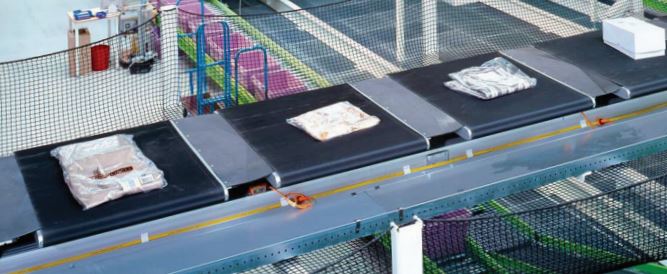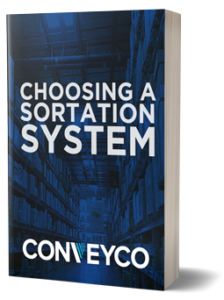
Unit Sorters
Unit Sortation has the ability to handle individual items on a sorter and can yield great efficiencies to an operation that can dramatically impact the total throughput of a facility. These improvements can be felt in order selection, packing, and outbound shipping sortation.
Need an Expert Opinion?
Many of these systems are loop sorters because their orientation is commonly a closed circular loop. Below is a listing of some of the unit sortation technology that can be applied to a solution.
Types of Unit Sorters:
Unit sorters allow warehouse operations and distribution centers to increase their level of operational efficiency, reduce labor costs, and more. While this technology is available and valuable to all, understanding how to leverage it can be difficult depending on the size and layout of your warehouse.
1. Bombay Sorter
What is a Bombay Sorter?
A Bombay Sorter also known as a flat sorter is used for high speed automated sortation of small lightweight items. These items would be too small and light to be handled by a typical conveyor system and included bagged garments, Jewelry, pharmaceuticals, CDs, mail, books, and small parcels.
Bombay Sorters are typically found in distribution centers that do a lot of direct to consumer operations. The Bombay Sorter handles similar items and operates in the same way that a tilt tray or crossbelt sorter would. Bombay Sorters typically have hundreds of sort locations making these sorters rather long. However, they do make good use of space with sort locations as close to each other as 18” center to center.
These sorters can be engineered to have curves and designed to fit tight warehouse spaces. The item being sorted can either have an operator manually place items on the sorter or have an automated induction system that handles getting the items on the sorter. Once the items are on the sorter they are then scanned and assigned a location to be sorted to. Unlike the Tilt Tray Sorter and the Crossbelt Sorter, the Bombay Sorter items fall through a trapdoor to arrive at its sorted location, hence the name. The items can be sorted into a chute for further processing or dropped directly into a carton or tote ready to ship to its customer.
2. Pouch / Pocket Sorters
What is a Pocket Sorter?
A pocket sorter is a type of unit sorter that acts as a storage and retrieval system via a series of pockets, bags, and pouches. A batch of units is picked then placed one at a time into bags hanging from an overhead trolley (one unit per bag). The bags are then stored in an automated buffer until enough units have been put into the system to complete order or a wave of orders. The system automatically retrieves and sorts the wave of units into discrete orders and sequences them (in any order) to packing stations.
3. Crossbelt Sorter
What is a Crossbelt Sorter?
The Crossbelt or Loop Sorter is a chain of many short belt conveyors riding on a track that is on a continuous loop. Every single belt carries one item to be sorted. When the item is ready to be discharged the belt will run across the flow of the loop and divert the item to either side of the system. This configuration makes the Crossbelt Sorter a highly efficient mechanism, requiring minimal space for high volume item sortation.
Crossbelt sortation conveyors can be fed by automated induction stations, or by operators manually. Scanners match an item barcode to a belt section and track the item to the correct destination. These sorters often feed customizable chutes that allow a single divert location to create multiple orders. Crossbelt Sorters are superior to use after a wave pick or batch pick operation.
This particular sortation can be designed in 2 different configurations; Horizontal Sortation which is circular and Vertical Sortation which is in a linear format. These conveyors are the RightFIT solution for operations that require a higher volume of throughput, a wide range of product shapes and sizes, or have narrow footprints and many different processing stations. This technology has been widely used in many industries including grocery, apparel, and e-commerce.
4. Tilt Tray Sorter
What is a Tilt Tray Sorter?
A Tilt Tray Sorter is a specific type of continuous loop sorter, which is a highly accurate, high-speed method of sortation. A continuous loop sorter consists of a rail or track configured in an endless loop on which individual carriages ride at speeds of up to 590 feet per minute. The carriages are connected together to form a chain, which is used to drive them along the track. Specific to the Tilt Tray sorter, each carriage is topped by a tray, commonly made of wood or plastic, that can be individually actuated to tilt to either one or both sides. The item on the tray is then deposited by gravity onto either a chute or a takeaway conveyor.
Items to be sorted can be manually deposited onto the trays by personnel, automatically inducted onto the trays by induction conveyor, or a combination of the two methods. Regardless of which method is used, the item placed onto the tray is tracked by controls software and is transferred to its correct location. This arrangement allows for sortation of up to 40,000 items per hour.
Tilt tray sorters are very versatile in that they can be used with virtually any type of packaging. Whether the item to be transferred is packaged in a carton, bag, or tote, if the item fits on the tray, it can be sorted efficiently, including very small or oddly shaped items. In comparison with other sortation technologies, a tilt tray sorter can be easily reconfigured or expanded with minimal difficulty. This technology has been widely and successfully used in many different industries, just a few of which are apparel, postal, publishing, and pharmaceutical.
Picking a Unit Sortation System
Ultimately, deciding on what Unit Sortation system is the best solution for your needs will depend on a number of different factors. You’ll need to consider the type and variety of product you handle, your average order size, and the throughput requirements. There are many types of unit sorters with powerful benefits for the right operation.
If you’re having trouble understanding which technology is the best fit for your operation, speaking with a trusted systems integrator can be a great place to start. Speak with one of our experts and we will help you reach your goals.











